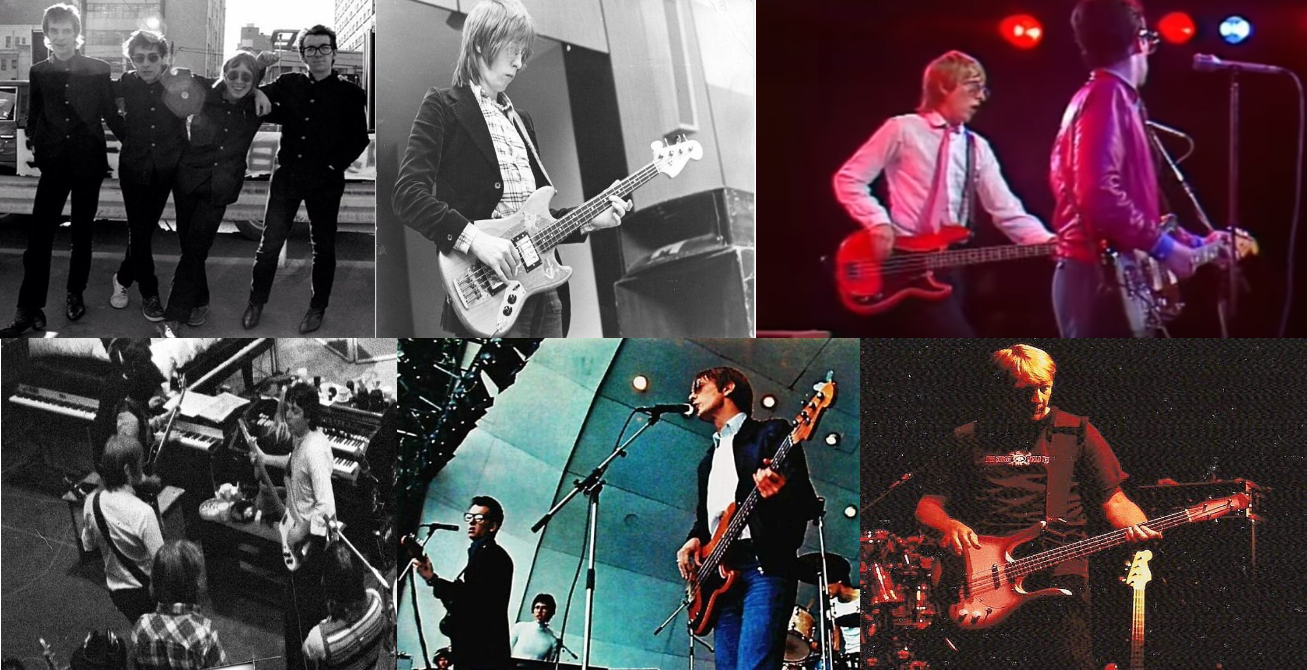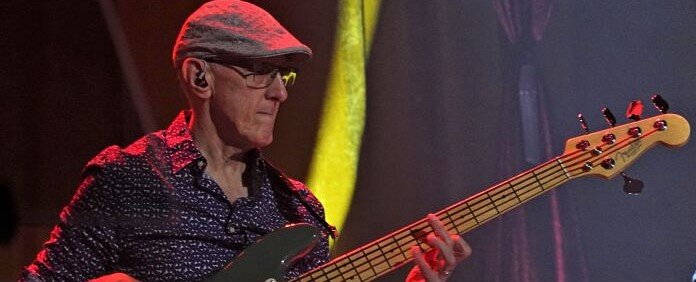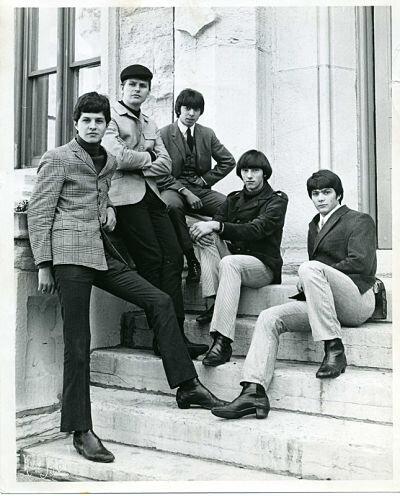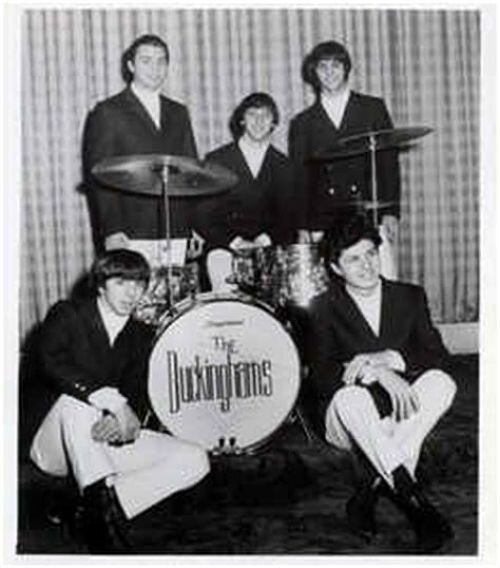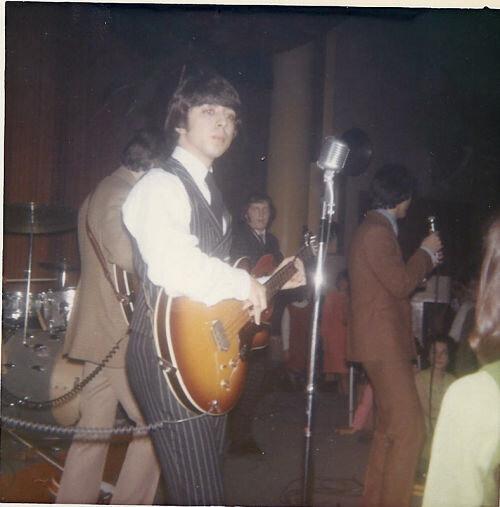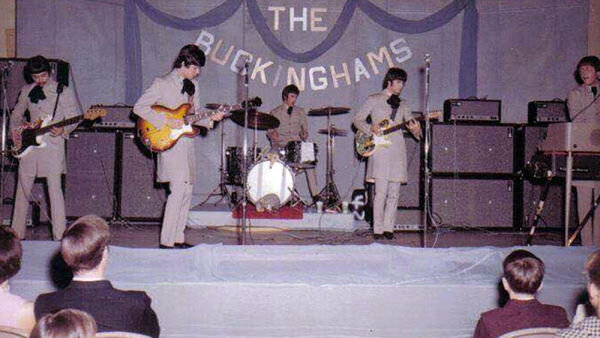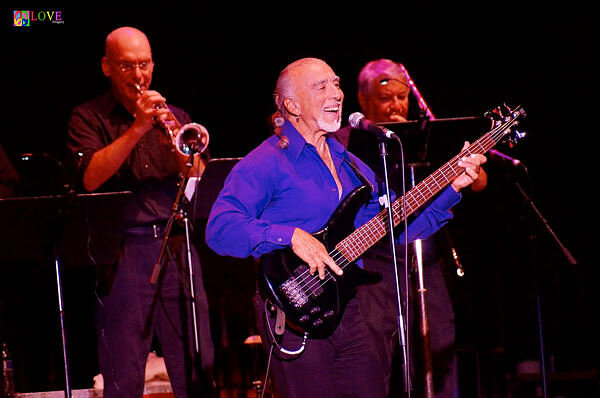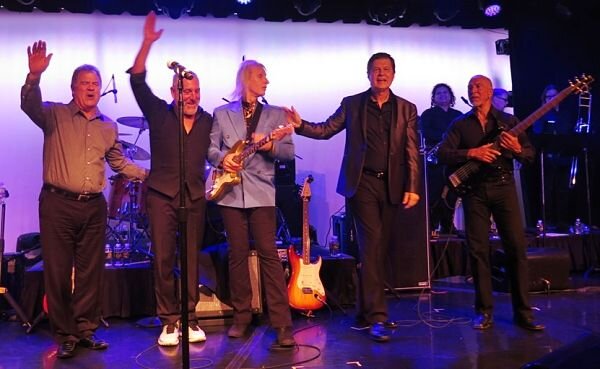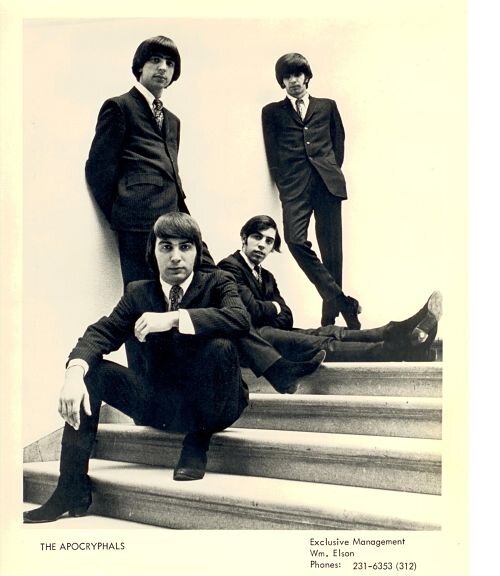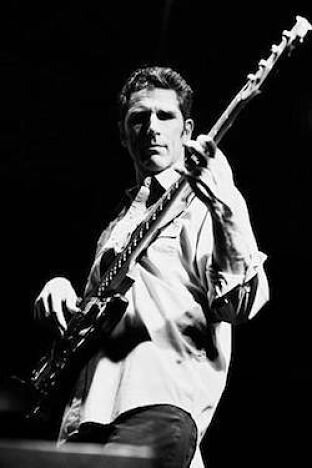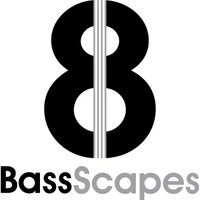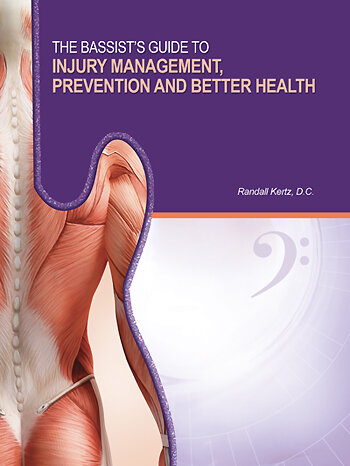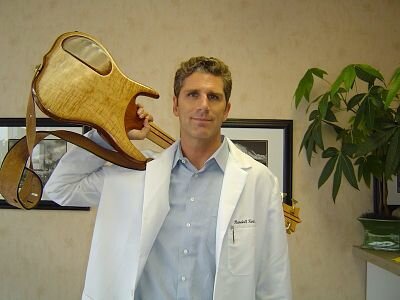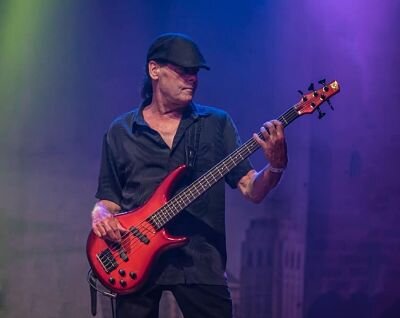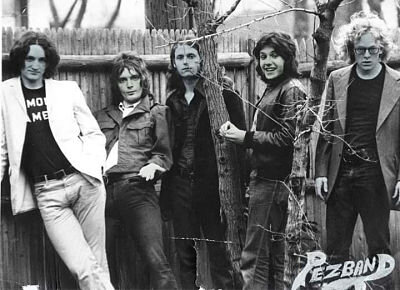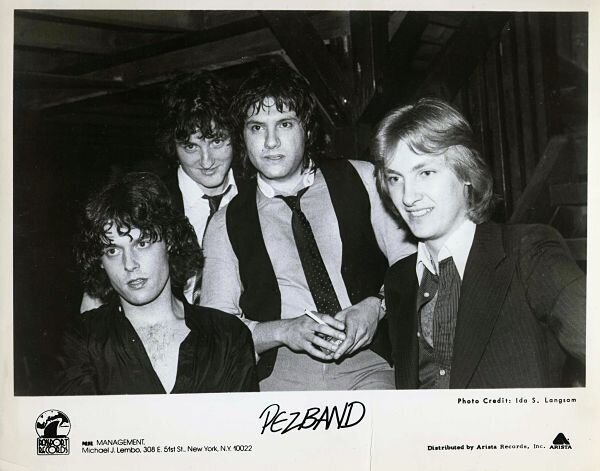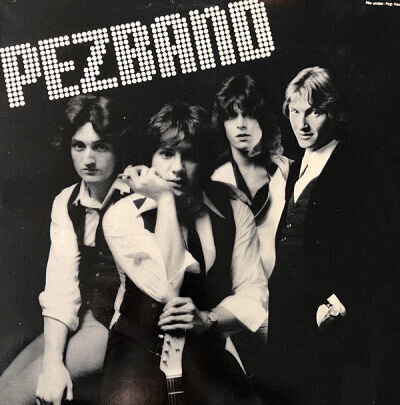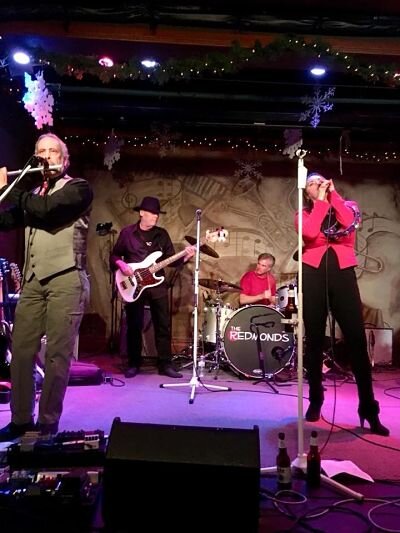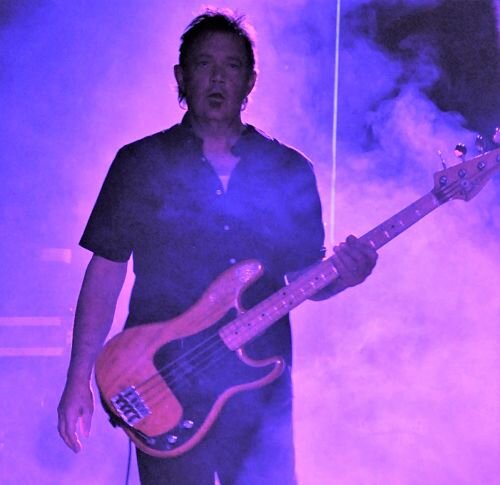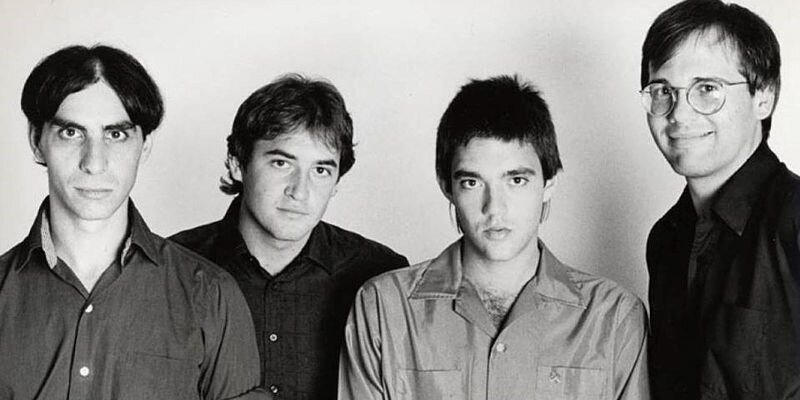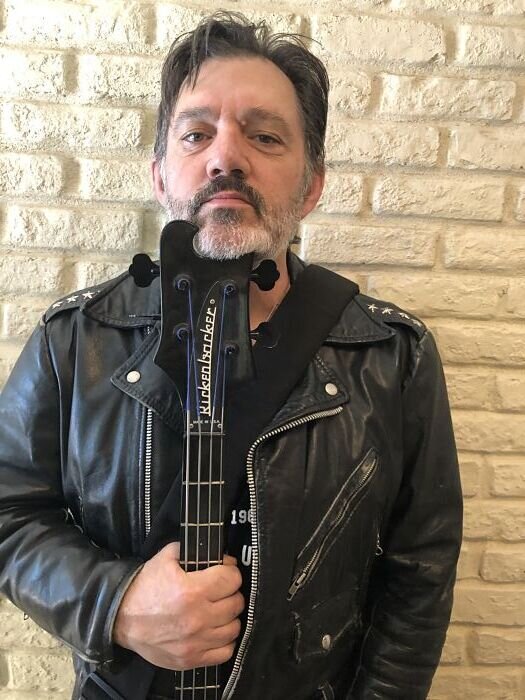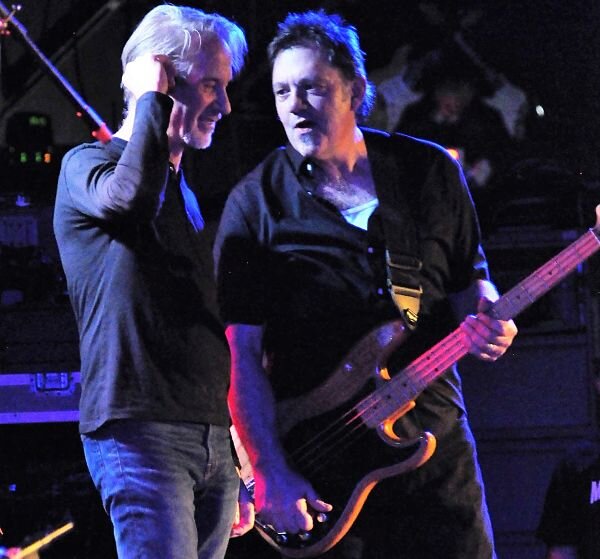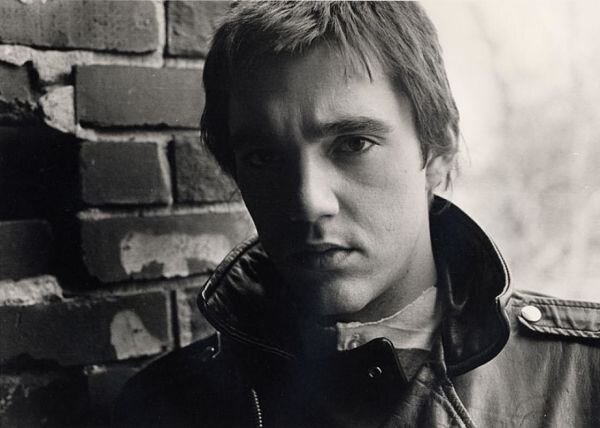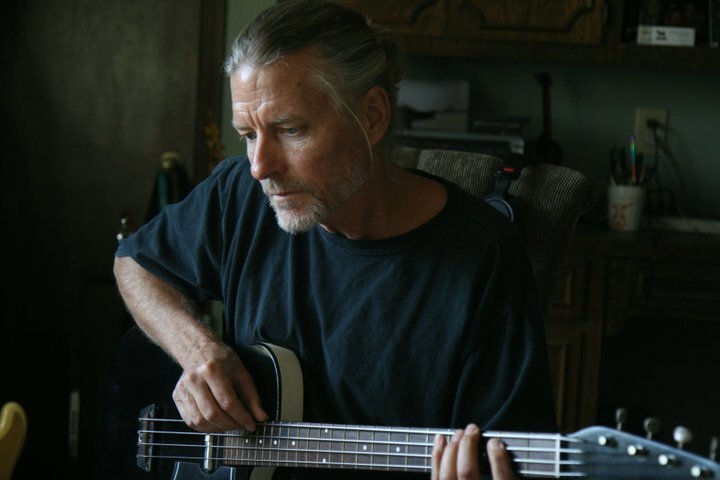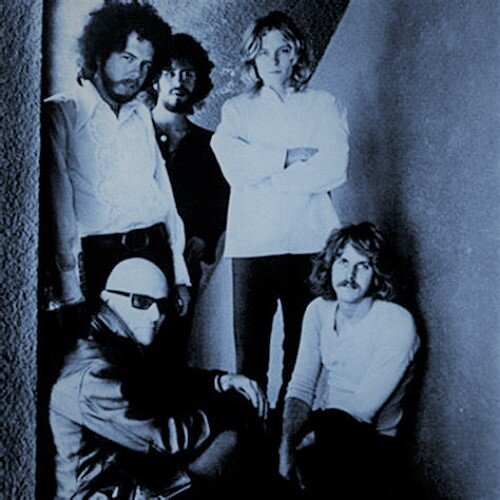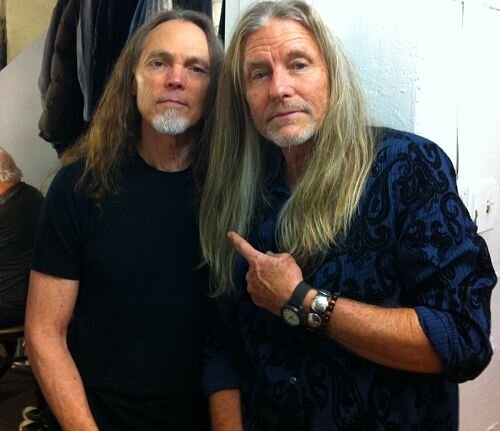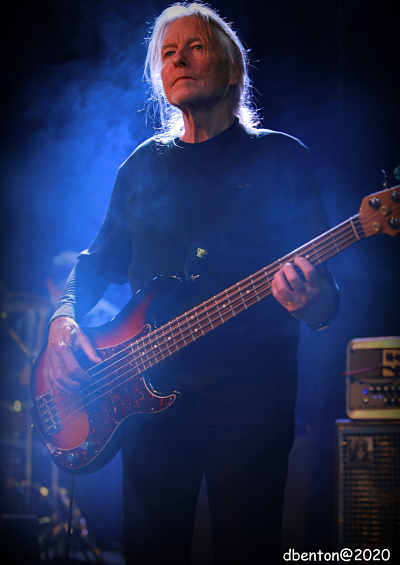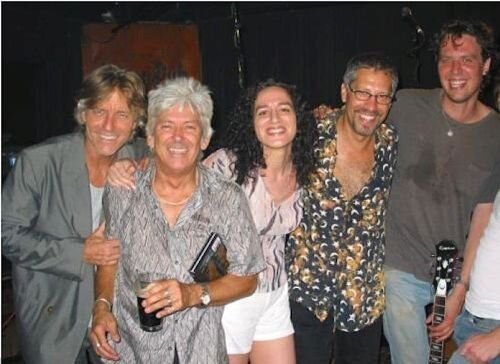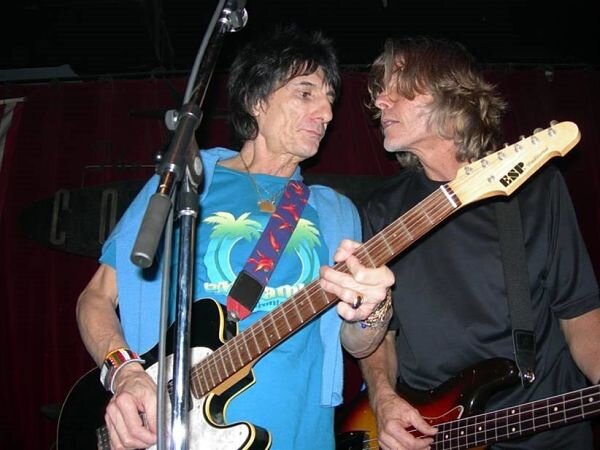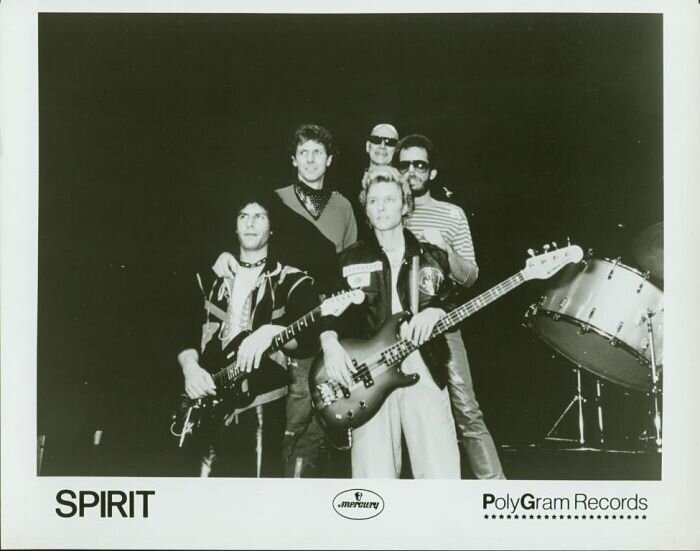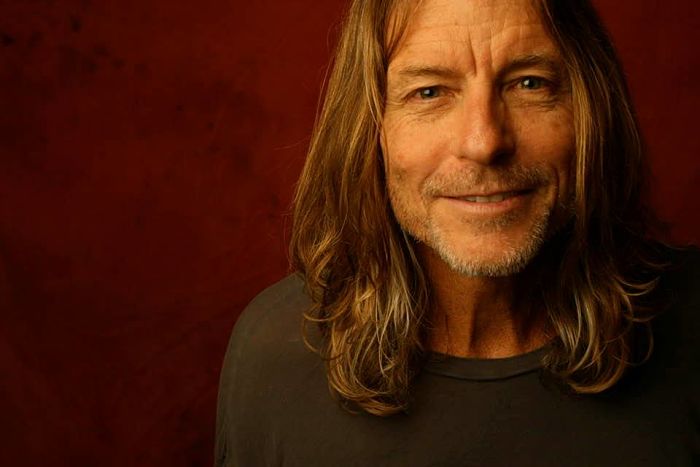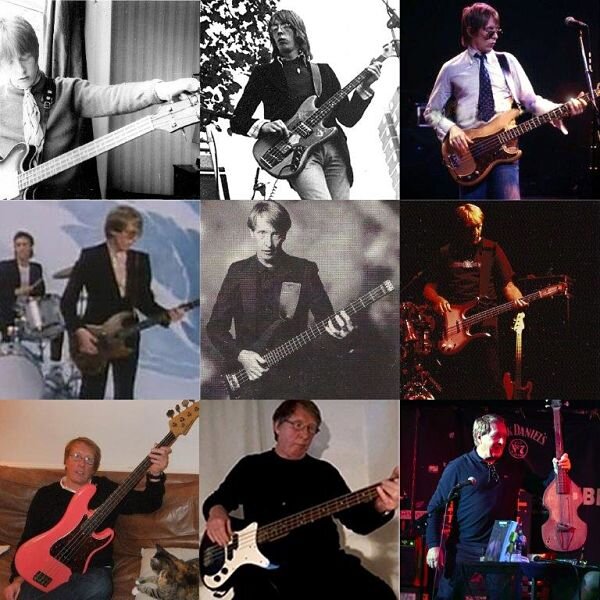
By Joe Gagliardo
Bruce Thomas’ tough melodic lines as anchor of Elvis Costello & The Attractions have inspired numerous players. Revered by his peers, a Beatle, and rock fans worldwide, Bruce’s outstanding career on stage and in the studio, before, during and after The Attractions, is the stuff of legend.
What did Bruce mean to Elvis’ Attractions? Bass Player magazine noted that “his bass lines consistently [bring] Costello’s songs to a new level with tasty, melodic parts that fit perfectly with the chords, melody and lyrics.”
Referencing “Everyday I Write the Book,” BP proclaimed that Thomas’ bass lines were “full of playful syncopations, chords, feel changes and slides, [and that] his part masterfully straddles the fine line between careful support and break-from-the-pack creativity.”
Bruce had no formal music training. Like many of us, as a kid he pressed his ear to the radio under the bedsheets at night to hear the bass. Radio Luxembourg was his pop music station of choice – among the shows he tuned into featured a broadcast from The Cavern in Liverpool, affording him the opportunity to hear bands that emerged on the heels of the Beatles’ success.
The Shadows were the first band Bruce saw perform live, and his attention was immediately drawn to legendary bassist Jet Harris and his signature red Fender Precision bass, which matched Hank Marvin’s red Fender Stratocaster guitar. The song “36-24-36” – a bass driven instrumental – was among Bruce’s favorite songs. Johnny Gustafson, the bassist with The Merseybeats, also caught his attention. Bruce describes the four cornerstones of bass as Paul McCartney, John Entwistle, Duck Dunn, and James Jamerson.
Bruce never desired to be a guitarist. Being attracted (pun intended) to the instrument by the music he was hearing, he tried to construct a bass using telephone parts as a pickup with a Spanish guitar bridge. It had an eleven-note octave on it because, somewhere along the way Thomas lost count!
Though Thomas had an affinity for bass, his gig as a harmonica player led to his first gig as a bassist. Inspired by the role the harmonica played in the music of the Rolling Stones, The Yardbirds, and the British r&b and blues groups, Bruce was working the mouth harp in a local band, The Tremors. One night the bass player didn’t show, and without even a brief rehearsal – the absent bassist’s blonde Epiphone Rivoli was handed to Bruce and he had to wing it. From that point on, he became a bassist – practicing for hours on end every day along with records, radio, and the television.
While toiling for newspaper company in the mid-60s, he and two of his co-workers, Paul Rodgers and Mick Moody would often discuss music and artists such as the Paul Butterfield Blues Band. As their friendship developed, Bruce was invited to join their band, The Roadrunners, which was a rhythm and blues, Motown soul ensemble.
Paul Rodgers had been The Roadrunners’ bassist- however he wanted to concentrate on singing and fronting the band. Hence Bruce took over, using Paul’s Vox bass, that is – until the neck perpetually bowed and the action got higher and higher to the point where Bruce was pulling the neck back in order to hit the right notes. The use of that instrument came to an abrupt end when the neck snapped.
The Roadrunners moved to London to seek fame and fortune, but broke up quickly thereafter. Fate was kind to Paul Rodgers who went on to play with Paul Kossoff, Andy Fraser, and Simon Kirke in Free, and later, with Mick Ralphs and Boz Burrell Bad Company, and Queen + Paul Rodgers, and is rightly considered one of the greatest rock vocalists of all time.
Mick Moody found success as well, joining Whitesnake, a band led by David Coverdale that would go on to platinum sales and filling arenas worldwide. Bruce auditioned for a pre-Fleetwood Mac Peter Green and Jeremy Spencer collective. Though that experience culminated in a “great two-hour jam,” Peter politely informed Bruce “you’ve got all the notes…but you don’t quite put them together.” According to Bruce it was too early in his playing career. Yet that incident was more than made up for years later when he and Peter Green jammed at the Marquee Club, and later played together on Peter Bardens’ solo album, The Answer.
Bruce had far better luck with keyboard player Peter Bardens, who formed the band Village – an organ, bass and drums trio. Following that audition, Bardens told Bruce “you’ve got the notes! And you’re the only player I’ve heard all week who can actually swing!” That was a heavy compliment, considering the line up in Bardens’ previous band had included Mick Fleetwood, Rod Stewart and Peter Green!
Village worked up a jazzy rhythm and blues repertoire featuring material by the likes of Jimmy Smith and Miles Davis. The band earned a residency at the prestigious Marquee Club, where support acts for Village included Elton John and Brinsley Schwarz.
Each week, Village invited special guests to perform with them, giving Bruce the opportunity to hone his skills working along London’s best musicians. Among those guests once again was Peter Green which Bruce recalls as a highlight of his career. It wasn’t just talent or technique according to Thomas, “yes, he had taste and fire, but his playing came from deep inside of his soul … it is rare to hear someone play as deep as Peter Green.”
By 1971 Bruce was playing with renowned guitarist Tim Renwick in Quiver. The band created a buzz, playing at a celebrity party the Stones held by the river at Bray; gigging with Pink Floyd; and supporting The Who in their prime during their Who’s Next tour. One of the band’s biggest fans was a drummer, who years later would become part of a legendary rhythm section with Bruce—his name was Pete Thomas.
The Sutherland Brothers, Iain and Gavin, were prolific songwriters for Island Records, and had their songs covered by other artists, including Rod Stewart (“Sailing”). They used studio players on their records, including members of Quiver. At the suggestion of the Brothers’ manager, the bands joined forces, and quickly went into the Island Records studio where Muff Winwood produced their single, “You Got Me Anyway,” which was a hit in the UK and U.S. The band, now known as The Sutherland Brothers and Quiver (“SB&Q”), supported Elton John at the onset of his popularity in the early 70s.
Suddenly, the band was playing large, prestigious venues including Madison Square Garden, the Hollywood Bowl, and football stadiums. One of the early shows on the tour involved an additional band on the bill, Steely Dan. Bruce was a fan of the band and its debut LP Can’t Buy A Thrill – admiring their stellar songwriting, musicianship, arranging, and production. Bruce’s yen for Steely Dan almost killed his chance to be an Attraction…
Following his tenure in SB&Q, Bruce was hoping to hook up with Wilko Johnson, who had recently left Dr. Feelgood. That gig didn’t pan out, so Bruce, feeling something new was percolating in the music scene, kept his eye on the “Musicians Wanted” column of Melody Maker. One day he saw an ad seeking a bass player and keyboard player for a “rocking pop combo.” He had recently read an article about a performer who was being touted as the next big thing and was in search of a backing band: Elvis Costello. Bruce’s intuition led him to think this ad related to Elvis Costello.
Bruce dialed the number, connecting with the office of Elvis’ label, Stiff Records and asked the receptionist about the artist who placed the advertisement. Her response was “he’s like Buddy Holly on acid!” Bruce immediately heard a voice in the background, later confirmed to be Elvis, shouting, “ask him who he likes!” Suzanne the receptionist did as she was instructed.
“What bands do you like?”
“The Rumour and Steely Dan…”
“Get rid of him!” the male voice shot back!
“No, I think you should give him a chance!”
Suzanne gave Bruce the details for the audition. And not long after, she became…. Mrs. Bruce Thomas.
Bruce purchased the records, learned the bass parts, and nailed the gig with the help of the drummer – Quiver’s biggest fan, Pete Thomas. According to legend, manager Jake Riviera was checking Bruce out, and Pete told Elvis and Jake, something to the effect that “if you don’t get this guy, you must be mad,” and that likely sealed the deal.
Among the most popular songs in The Attractions repertoire and a hit record on FM radio in America, “(I Don’t Want to Go to) Chelsea” is notable for Bruce’s prominent bassline, which was a spikier version of the riff John Entwistle played at the end of the live version of “My Generation.” Bruce’s basslines not only drove many of the songs, but he advocated for the name The Attractions because it was similar to Motown’s Temptations. And it stuck.
Bruce was a member of the Attractions from 1977-1988, and from 1994-1996, recording several albums, singles, and EPs, and touring the globe incessantly. His favorite records include This Year’s Model, Get Happy (twenty songs bursting with energy and melody, most under two minutes, many done in one take, and with few overdubs) and the baroque pop classic Imperial Bedroom.
All of Elvis’ albums with The Attractions are a showcase for Bruce’s stunning basslines. One that always jumps out at me (and scores of bassists) is “Lipstick Vogue” from the very first Attractions long-player This Year’s Model. Bruce has no idea where that hyperactive skittering bass part came from; he just started doing it. He has, however, explained the origins of some of the other songs. “The bass on ‘The Beat’ is like Paul McCartney’s on ‘Taxman,’ with additional flourishes you might hear on a guitar. ‘You Belong To Me’ is a reworking of a Solomon Burke riff.”
The title track “This Year’s Girl” is a hybrid of the Stones’ “Stupid Girl” and The Beatles’ “You Won’t See Me.” The bass line on “Pump It Up” was a combination of multiple songs. Rhythmically it was the same as “The Price of Love” by the Everly Brothers, the notes came from Richard Hell and the Voidoids’ “You’ve Got to Lose.” And he even filled the last space with the riff from the Kinks’ “You Really Got Me.”
In another twist, the bass on the chorus of “Pump It Up,” quotes “In The Mood,” as a tribute to Elvis’ dad, Ross McManus, whose band, Joe Loss and his Orchestra, used the song as its signature tune.
As per Bass Player magazine’s description of Bruce’s playing on Model, “Bruce rules the sonic landscape with killer tone, wicked articulation and inventive lines that seem to jump out of the mix and whack you across the face…it’s a must for any rock bassist seeking some inspiration.” Bruce’s parts on “Pump It Up,” “Chelsea,” and a number of other songs were played live in the studio, in one take!
A turning point for the band (and the history of rock and roll) was their legendary appearance on Saturday Night Live in December 1977. Overnight they went from a band for people in the know, to a band everyone knew. Before they hit the stage, Bruce and John Belushi duetted on a Willie Mabon song in the dressing room. Turns out Bruce’s rhythm and blues days served him well that night, as Belushi was asking if any of the band members were into the blues. It was a big night for Bruce and the band from beginning to end.
While recording the Armed Forces album in 1979, Bruce received an unexpected call in the studio asking whether he wanted to do a recording session with Paul McCartney, as if anyone could or would turn down an invite from Paul! When Bruce arrived at Abbey Road Studio 2, he found a “rock orchestra.” There were three of every instrument, all playing live in the studio akin to legendary producer Phil Spector’s “Wall of Sound.”
The two other bass players were John Paul Jones of Led Zeppelin and Ronnie Lane of the Faces. When Bruce told Paul he had taken a few of his motifs over the years, to Bruce’s surprise, Paul picked up a bass, and played a few licks from “Chelsea.”
The “Rockestra Theme” that was recorded that day won a Grammy for Best Instrumental Performance in 1980, and Bruce got to reprise his recordings with Sir Paul, as well as some Little Richard songs, when both Elvis and The Attractions and Sir Paul were on the bill for the benefit for Kampuchea which took place at the Hammersmith Odeon.
“Rockestra” https://youtu.be/zeeTlfbsKL8
Bruce’s second brush with a Beatle involved John Lennon and Yoko Ono. Mrs. Lennon was assembling an album of her songs as a memorial to John, and Elvis and the Attractions contributed a New Orleans and Meters-inspired version of “Walking On Thin Ice,” a track produced by Allen Toussaint.
Thomas feels that Imperial Bedroom (1982) marked a watershed moment in his playing. On “Shabby Doll,” he plied the riff with the added-9th harmony that a jazz bassist had shown him years earlier. On “Human Hands,” he rendered a verse using bass chords, and on “The Loved Ones,” he came up with a walking bass line that could walk alongside Paul’s brilliant passage on “All My Loving.”
Though there were breaks in the action, Elvis and The Attractions had a stellar career in the studio, and on stage, and it culminated with their 2003 induction into the Rock and Roll Hall of Fame.
Outside of his tenure in The Attractions, Bruce did plenty of studio work, including a session with the notoriously moody Chrissie Hynde. The project included a new group of players, as the founding Pretenders bassist and guitarist had passed, and the original drummer Martin Chambers didn’t play on the record. Bruce appeared on only one track, “My Baby,” due to creative differences as to the approach i.e. functional playing versus creative playing. Admonished Ms. Hynde “in The Pretenders we don’t go above the fifth fret!”
Among Bruce’s more pleasant experiences was recording with John Wesley Harding – with Pete Thomas, including a killer version of Tommy James’ classic “Crystal Blue Persuasion.” Bruce recorded with Al Stewart, Madness, Billy Bragg, and Tasmin Archer, among many others. Bruce was especially impressed with Suzanne Vega, helming the bass chair for her album 99.9 F. Bruce used a Danelectro Longhorn on the Vega recordings, as well as on many of his other studio sessions.
Bruce also collaborated with his nephew – writing and producing dance and “chill-out” music under various names. That music was pressed onto 12-inch records and was popular with DJs spinning music in the dance clubs back in the days when vinyl was the preferred medium.
In 2017 Bruce recorded a ten-track collaborative album with singer-songwriter Spencer Brown entitled Back To The Start. The partnership started informally when Spencer asked Bruce to listen to a few songs he was working on…and Bruce came on board to play and arrange the record.
Style: One of the first bass parts Bruce learned was Booker T & The MG’s classic “Green Onions.” Though it was an easy three-note riff (rendered by original MG’s bassist Lewie Steinberg, and not Duck Dunn, whom it is often attributed to) more importantly, it taught him how to play a groove. In terms of his active bass lines, Bruce attributes that influence to Jack Bruce and the Fresh Cream LP, as well as to McCartney and Entwistle, along with US players such as Jamerson, Phil Lesh, and Jack Casady. In the Attractions, he had the ability to play the active bass lines he created, in part, because Elvis told the band early on that there would be no guitar solos in his band, so it gave Bruce space to play creatively.
Approach: In terms of Bruce’s approach, timing is his priority, and melodically distinctive notes come in second. Tone is also essential to Thomas – he stresses that the tone of a bass guitar emanates from the player. That is, where you hit the strings, how near to the bridge, tension and relaxation, how you release the note — and many other factors!
Elvis and The Attractions mostly played live on backing tracks when recording their LPs. However, Bruce altered his work method in the studio with other artists. On occasion he would render a guide part to help the musicians while the basic track was recorded, then cut his final track when the overdubs and vocal parts were done. When putting the master bass part on, he would not concentrate on binding the chords to the rhythm. Instead, he would try to tie the vocal to the drums, taking harmonic cues from the vocal melody and inflections, and bring the voice and drums together.
At the height of The Attractions popularity, Bruce was famous for his “salmon pink” Fender Precision bass, strung with Rotosound Round Wounds gauge 55-115 (nowadays he uses Base Centre Elites with a more conventional 45-105). Back then a P bass cost a fortune in the UK – almost a year’s salary for working class players. Bruce’s purchased a used Precision, and stripped it back to the wood grain, and added a tortoise shell scratch plate. When he attempted to replicate Jet Harris’ instrument, faded fiesta red, the color turned a shade of pink. He would sometimes add a wad of foam by the bridge to have better articulation of the notes.
Unfortunately, Bruce’s pink P was stolen from his car while he was in Los Angeles working sessions. Though he tried to find a suitable replacement, it wasn’t simply a matter of replacing an early 1960s P-bass, as he had made many modifications to it. Bruce had reshaped the body and the neck, rewired it and re-sprayed it. As a result, after much searching with no luck, he concluded that he would have to reproduce it from scratch.
When Bruce informed Barry Moorhouse of the Bass Centre in London of his mission to replicate his signature instrument Barry felt that other players would be interested in having a similar bass, hence the creation of the BT signature model bass as part of their new British Bass Masters series.
http://www.basscentre.com/british-bass-masters/bruce-thomas-profile.html
Bruce is also partial to Danelectro basses, which he used during the 1990s on stage and in the studio with The Attractions, and in the studio with other artists. He likes the Danelectro Longhorn Rumor with the built-in Chorus, and Hodad basses. Over the years, Bruce has used multiple basses, including a Gibson EB-0, Fender Mustang, Fender 6-string, Hagstrom 8-string, Hamer 8-string, and Hamer 12-string.
His bass rigs have gone from a Traynor Mono Block with two cabs each containing 2 x 12s and a 1×18, to two Ampeg SVTs, to two early Trace Elliot heads with 4 4×10 cabinets stacked side-by-side.
For a deeper dive into his life and music career, check out Rough Notes…and Grainy Images, published in 2017, which is both an autobiography and cultural history, covering his entire career in music.
His website https://www.brucethomas.co.uk/ is also a wealth of information.
Select Bruce Thomas tracks with The Attractions!
Elvis and the Attractions-Live-Théâtre de l’Empire à Paris (1979) https://youtu.be/rzsWpYQ2mIs
“Lipstick Vogue” https://youtu.be/J3sqZUMgcX4
(I Don’t Want to Go To) Chelsea-Live at Rockpalast https://youtu.be/ITx5vzQi0go
“Oliver’s Army” https://youtu.be/LrjHz5hrupA
“Everyday I Write the Book” https://youtu.be/V1d4r9awjKE
“Pump It Up” https://youtu.be/3Y71iDvCYXA
(“What’s So Funny ‘Bout) Peace Love and Understanding https://youtu.be/Ssd3U_zicAI
With Suzanne Vega:
“99.9F” https://youtu.be/uEvjFThqmq0
With Spencer Brown:
“Back to the Start” https://youtu.be/QYM1EIztn4I
“Thursday” https://youtu.be/_XLMbZE_ZvA
“Fall On You” https://youtu.be/nUWj_OiGf1s
